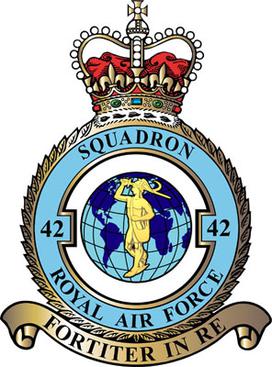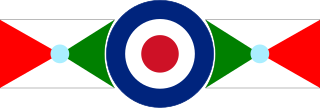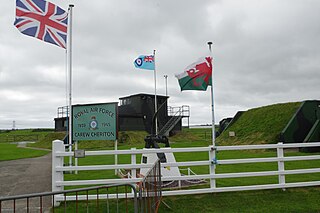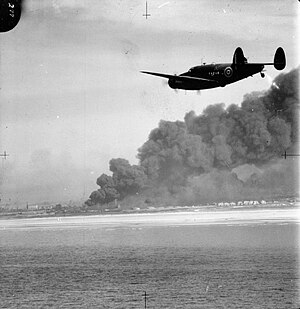
No. 206 Squadron is a Test and Evaluation Squadron of the Royal Air Force. Until 2005 it was employed in the maritime patrol role with the Nimrod MR.2 at RAF Kinloss, Moray. It was announced in December 2004 that 206 Squadron would disband on 1 April 2005, with half of its crews being redistributed to Nos. 120 and 201 Squadrons, also stationed at Kinloss. This was a part of the UK Defence Review called Delivering Security in a Changing World; the Nimrod MR.2 fleet was reduced in number from 21 to 16 as a consequence.

Number 42 Squadron was a squadron of the Royal Air Force. It served during the First World War as an army co-operation squadron and during the Second World War in various roles. Between 1992 and 2010, it was the Operational Conversion Unit (OCU) for the Hawker Siddeley Nimrod MR.2, based at RAF Kinloss, Moray, until the Nimrod MR.2's retirement in March 2010. No. 42 Squadron disbanded on 26 May 2011.

Number 47 Squadron is an inactive squadron of the Royal Air Force. Previously based at RAF Brize Norton, Oxfordshire, it last operated the Lockheed Martin Hercules C4/C5 between 2013 and 2023. It previously flew the Lockheed Hercules C.1/C.3 between 1968 and 2013.
No. 119 Squadron RAF was a squadron of the Royal Air Force, flying with RAF Coastal Command during the Second World War. It was the only RAF unit flying the Short G class and Short C class flying boats.

No. 253 Squadron was a flying squadron of the Royal Air Force between 1918 and 1947. Originally formed in 1918, it served in WW1 flying coastal reconnaissance and anti-submarine patrols. Later in WW2 it took part in the Battle of France, the Battle of Britain, and then fought in the Mediterranean Theatre of Operations in Algeria. The squadron was disbanded on 16 May 1947, and briefly revived as a night-fighter squadron from 18 April 1955 to 2 September 1957.
No. 203 Squadron RAF was originally formed as No. 3 Squadron Royal Naval Air Service. It was renumbered No. 203 when the Royal Air Force was formed on 1 April 1918.

No. 205 Squadron was a Royal Air Force unit formed on 1 April 1918. Prior to this it had existed as No. 5 Squadron of the Royal Naval Air Service (RNAS). In 1929, it became the first RAF squadron to be permanently based in Singapore, taking as its motto Pertama di Malaya. No. 205 Squadron operated during World War II and the Cold War before disbanding on 31 October 1971.
No. 204 Squadron was a Royal Air Force unit first formed in March 1915 as No.4 Squadron Royal Naval Air Service.

No. 269 Squadron RAF was a maritime patrol unit of the Royal Air Force that saw service in World War I, World War II, and the Cold War.

Royal Air Force Carew Cheriton, or more simply RAF Carew Cheriton, is a former Royal Air Force station located near Carew, Pembrokeshire. It was situated 4.7 miles (7.6 km) north west of Tenby.

No. 223 Squadron RAF was a squadron of the Royal Air Force. Originally formed as part of the Royal Naval Air Service (RNAS), the Squadron flew in both World Wars.
No. 218 Squadron RAF was a squadron of the Royal Air Force. It was also known as No 218 Squadron after the Governor of the Gold Coast and people of the Gold Coast officially adopted the squadron.
No. 248 Squadron was a squadron of the Royal Air Force, active immediately after World War I, and again during World War II.
No. 82 Squadron RAF was a Royal Air Force squadron that was first formed in 1917 and last disbanded in 1963. It served at times as a bomber unit, a reconnaissance unit and lastly as an Intermediate Range Ballistic Missile (IRBM) unit.
No. 144 Squadron RAF was a squadron of the British Royal Air Force. It was first formed in 1918 during the First World War, operating as a bomber squadron in the Middle East. It reformed in 1937, serving in the bomber and anti-shipping roles during the Second World War. A third incarnation saw the squadron serving as a strategic missile squadron during the late 1950s and early 1960s.
No. 107 Squadron RAF was a Royal Flying Corps bomber unit formed during the First World War. It was reformed in the Royal Air Force during the Second World War and was operational during the Cold War on Thor Intermediate Range Ballistic Missiles.
No. 98 Squadron was a Royal Air Force bomber squadron during World War I and World War II. It flew fighter-bombers post-war, and converted to fighters in 1955. Reformed as a ballistic missile unit between 1959 and 1963, its final incarnation was as a radar calibration unit. It was disbanded in 1976.
No. 254 Squadron of the Royal Air Force was the designation of a number of units formed throughout the 20th century.
No. 240 Squadron RAF was a Royal Air Force flying boat and seaplane squadron during World War I, World War II and up to 1959. It was then reformed as a strategic missile squadron, serving thus till 1963.
No. 252 Squadron RAF was a Royal Air Force (RAF) squadron that formed as a bomber unit in World War I and re-formed as part of RAF Coastal Command in World War II.










